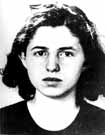
|
|
|

|

|

|

|
|
Click on an image to see a larger, more detailed picture.
|
|
|
|
|
| 1942: The "Final Solution" |

|
pg. 323 |

|
|
|
|
| |
 A poster advertises the anti-Bolshevik Nazi propaganda exhibit that was displayed in the Berlin Lust-garten. The exhibit, entitled The Soviet Paradise, was designed to demonstrate the superiority of Nazism over communism. The Nazi propaganda machine worked tirelessly throughout the war years to bolster the regime's military campaigns. The exhibit was particularly repugnant to the Baum Group since most of its members belonged to Communist and other left-wing organizations.
A poster advertises the anti-Bolshevik Nazi propaganda exhibit that was displayed in the Berlin Lust-garten. The exhibit, entitled The Soviet Paradise, was designed to demonstrate the superiority of Nazism over communism. The Nazi propaganda machine worked tirelessly throughout the war years to bolster the regime's military campaigns. The exhibit was particularly repugnant to the Baum Group since most of its members belonged to Communist and other left-wing organizations.
Photo: Bildarchiv Preussischer Kulturbesitz / United States Holocaust Memorial Museum Photo Archive
|
 Hella Hirsch belonged to the Baum Group. On May 18, 1942, Hirsch and other members of the group set fire to an anti-Bolshevik exhibit on display in Berlin. The Gestapo arrested 500 Berlin Jews in reprisal for the attack, shooting 250 of them and sending the rest to the Sachsenhausen, Germany, concentration camp. Hirsch and the others in her immediate group, 12 altogether, were tried on December 9, 1942. Nine were given death sentences. Hirsch was sentenced to just three years in prison due to "extenuating circumstances."
Hella Hirsch belonged to the Baum Group. On May 18, 1942, Hirsch and other members of the group set fire to an anti-Bolshevik exhibit on display in Berlin. The Gestapo arrested 500 Berlin Jews in reprisal for the attack, shooting 250 of them and sending the rest to the Sachsenhausen, Germany, concentration camp. Hirsch and the others in her immediate group, 12 altogether, were tried on December 9, 1942. Nine were given death sentences. Hirsch was sentenced to just three years in prison due to "extenuating circumstances."
Photo: Bildarchiv Preussischer Kulturbesitz / United States Holocaust Memorial Museum Photo Archive
|
|
Baum Gruppe Named after its leaders, Herbert and Marianne Baum, the Baum Gruppe (Baum Group) was diverse in its membership but unified in its opposition to the Nazis. Founded in 1937 and composed mainly of young Jewish Communists, the group also included fervent, left-wing Zionists. Most of the members were in their early 20s. The Baum Group produced and distributed anti-Nazi pamphlets, arranged educational events for the increasingly isolated Jewish youth of Berlin, and offered moral support and camaraderie. In May 1942 members engaged in a daring anti-Nazi act, an attempt to burn down an anti-Bolshevik propaganda exhibit called Das Sowjetparadies (The Soviet Paradise). Herbert, Marianne, and about 25 other members of the group were caught, tortured, and either killed or sent to concentration camps. Five hundred Berlin Jews not associated with the group also were arrested in reprisal and sent to camps or killed.
|
|

|

|

|

|
 May 26, 1942: Great Britain and the Soviet Union sign a mutual assistance treaty.
May 26, 1942: Great Britain and the Soviet Union sign a mutual assistance treaty.
|
 May 27, 1942: Belgian Jews are ordered to wear the Yellow Star.
May 27, 1942: Belgian Jews are ordered to wear the Yellow Star.
|
 May 27, 1942: Jozef Gabcik and Jan Kubis, British-trained Czech partisans armed with small arms and grenades, mortally wound Reinhard Heydrich, chief of the Reich Security Police and SD, in an ambush of his car in Prague; See June 4, 1942.
May 27, 1942: Jozef Gabcik and Jan Kubis, British-trained Czech partisans armed with small arms and grenades, mortally wound Reinhard Heydrich, chief of the Reich Security Police and SD, in an ambush of his car in Prague; See June 4, 1942.
|
 May 29, 1942: Vichy France forbids Jews access to all restaurants and cafes, libraries, sports grounds, squares, and other public places.
May 29, 1942: Vichy France forbids Jews access to all restaurants and cafes, libraries, sports grounds, squares, and other public places.
|
 May 29, 1942: Three thousand Jews led by Asher Czerkaski resist Germans at Radziwillow, Ukraine; 1500 are killed but the others melt into nearby forests.
May 29, 1942: Three thousand Jews led by Asher Czerkaski resist Germans at Radziwillow, Ukraine; 1500 are killed but the others melt into nearby forests.
|
 May 29, 1942: In the Warsaw Ghetto, an ill Jewish man is tossed through a window to the ground, where he is shot.
May 29, 1942: In the Warsaw Ghetto, an ill Jewish man is tossed through a window to the ground, where he is shot.
|
 May 30, 1942: Britain's first 1000-bomber raid on Germany (the target is Cologne) encourages Jews to hope that the war might soon be over.
May 30, 1942: Britain's first 1000-bomber raid on Germany (the target is Cologne) encourages Jews to hope that the war might soon be over.
|
|
|
|
|
| 1942: The "Final Solution" |

|
pg. 323 |

|
|
The Holocaust Chronicle
© 2009 Publications International, Ltd.
|
|
